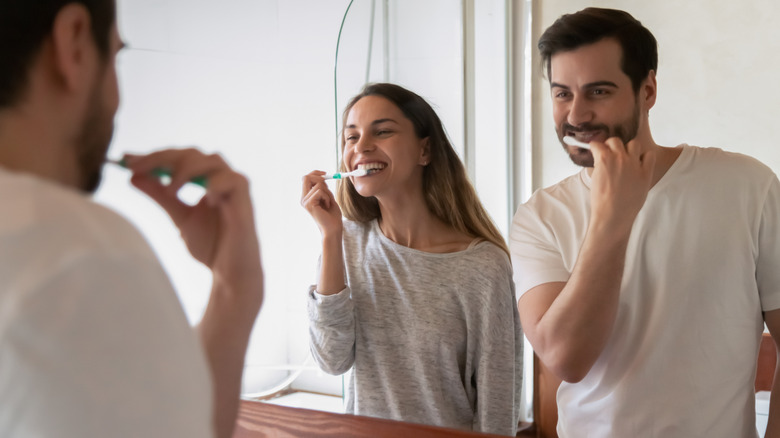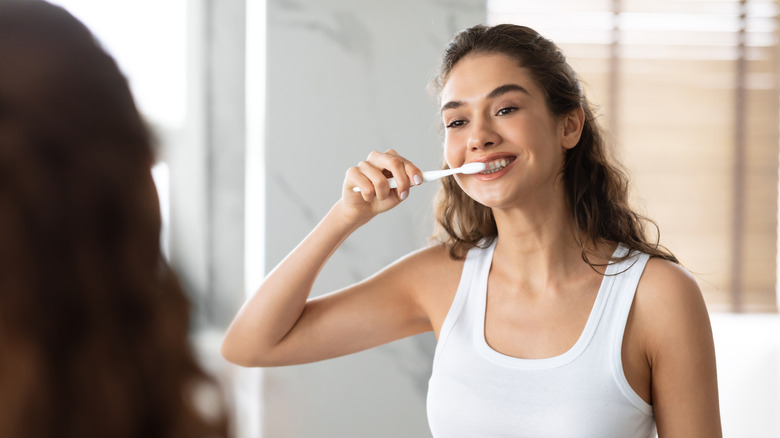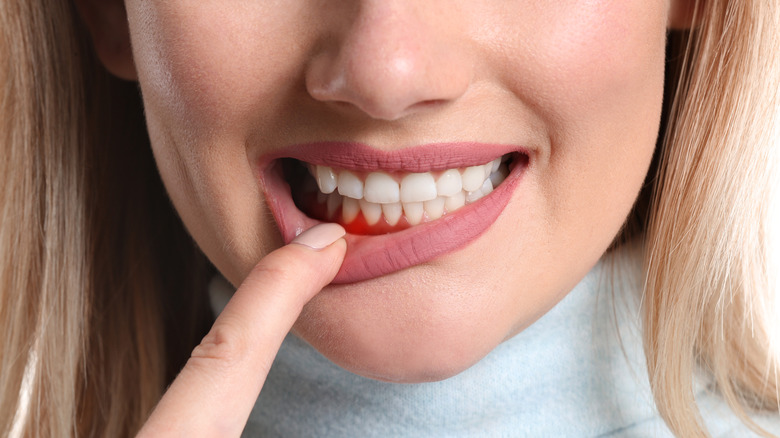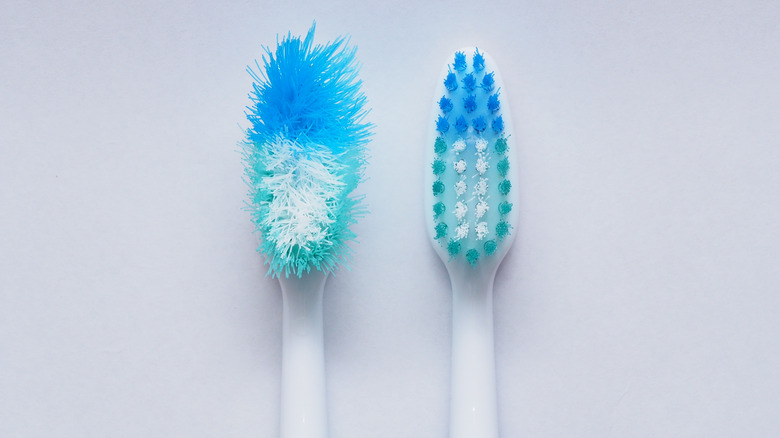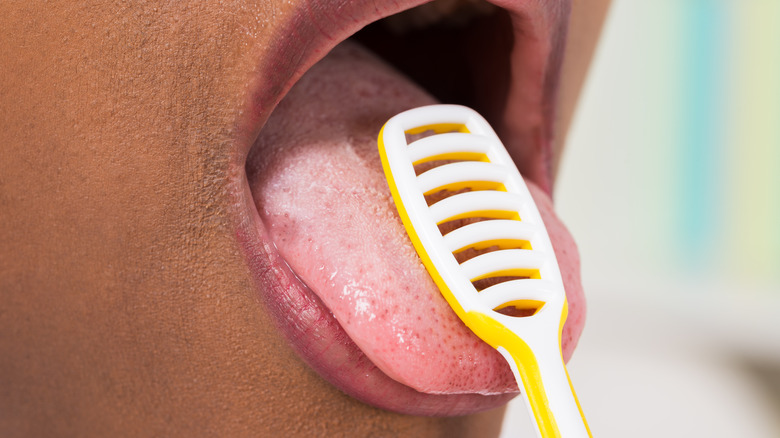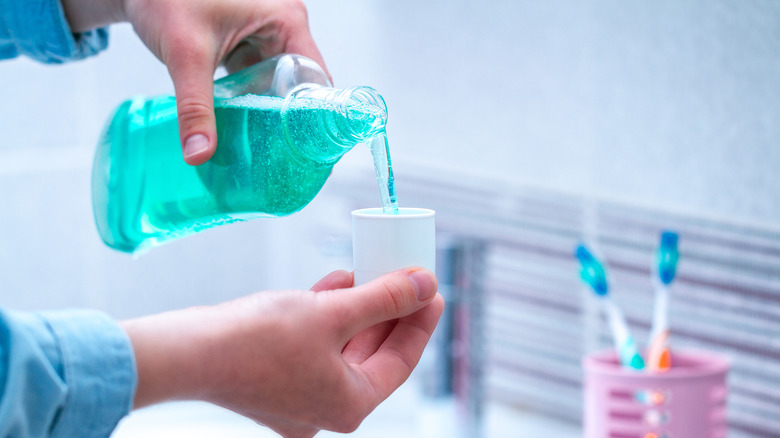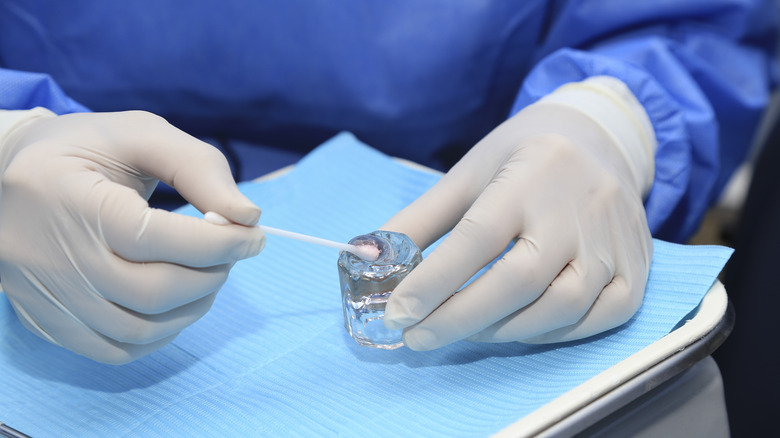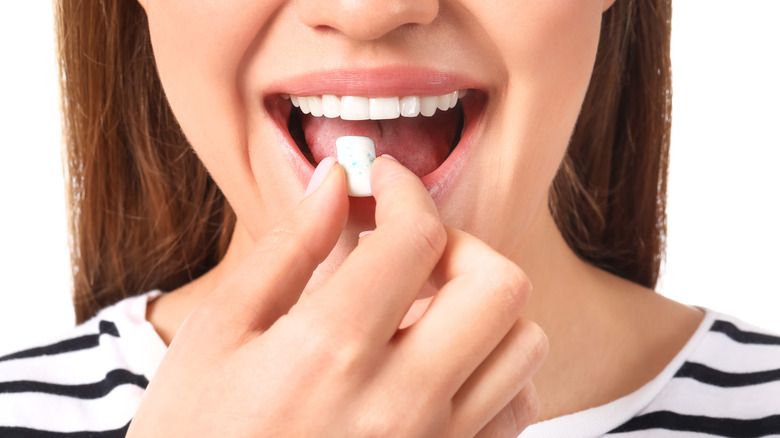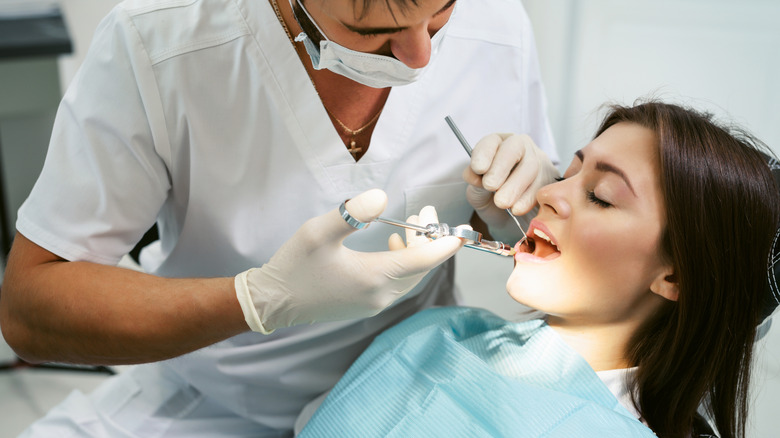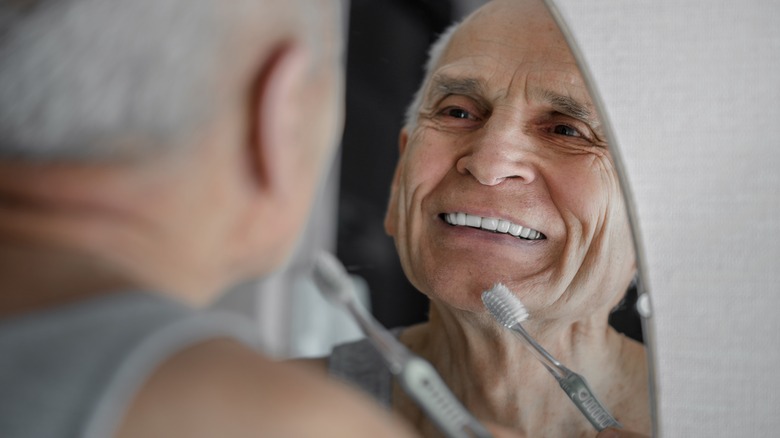The Ultimate Guide To Keeping Your Teeth Clean And Healthy
In the overall scheme of things, teeth might seem like a small part of the body and not as deserving of attention as other parts. Taking care of your teeth can feel like a constant chore — and because of that, you've probably gone to sleep once or twice without brushing. A bad toothache, however, can put you out for the day, or even longer. And a cavity with a trip to the dentist is no laughing matter.
So as tedious as it seems, keeping up with your oral health is important. Unfortunately, brushing and flossing might not be enough. Depending on your type of teeth, gum health, daily habits, and even genetics, your oral health might hinge on much more than scrubbing your pearly whites once or twice a day. Let's not get too overwhelmed though — here, we've created a helpful guide so you can keep your teeth healthy and in tip-top shape.
Brush daily
It's no secret that brushing twice a day is recommended by all dental professionals — but many people try to get away with brushing only once a day. Even with a busy schedule, the team at River Run Dental urges sticking to a twice-a-day schedule as much as possible. Only brushing your teeth at night will put you at risk for developing gum disease — while only brushing in the morning may lead to cavities (per River Run Dental).
Brushing at night is more of a no-brainer as compared to morning brushing — you simply brush and floss before you go to sleep. Morning brushing has some controversy though. Healthline admits that most professionals don't teach their patients whether to brush before or after breakfast. Although it can be done at either time, brushing before eating will have more benefits (per Healthline). Brushing before breakfast will help stimulate the production of saliva and it is also more beneficial for your tooth enamel.
Of course, brushing your teeth the correct way is also vitally important for this daily activity to benefit your overall oral health. And keep in mind that brushing may not be as much of a no-brainer as you think it is.
Floss regularly
Not flossing your teeth can be just as detrimental as not brushing them. Flossing at least once a day helps remove any food stuck between teeth and is especially important for those with tight teeth, as flossing will help remove food that your brushing just won't be able to dislodge. Jonathan Schwartz, DDS, tells Healthline that flossing is essential to reducing inflammation and stimulating the gums as well.
Healthline suggests that flossing just once a day is usually enough to get the benefits — so the ideal scenario would be to floss during your nighttime routine to remove any leftover food before settling in for the night. There are many types of dental floss and there's no right one for everyone — find the one that works for you. To help you determine which one that is, Oral B suggests dental tape or a type of spongy floss for those with wider gaps in their teeth or with braces, waxed floss for those with tight teeth, and pre-threaded floss if you want less mess.
Additionally, the Journal of Clinical Dentistry completed a study to find if there was any significant difference between electric and manual flossers and found that they were equally effective at cleaning plaque. The journal explains, however, that, "Since there was a marked preference for the automatic flosser, patient compliance with the automatic flossing device may be better than with manual floss."
Keep your gums clean
Unfortunately, the gums are often overlooked — in fact, many people don't know that poor gum hygiene can impact their overall oral health. Gingivitis, the early stages of gum disease, is painless and can be relatively easy to miss — many people have gingivitis for a long time and think that tender gums or bleeding while brushing their teeth is normal (via Healthline).
The good news is that gingivitis is reversible and can be treated. Deep cleaning is usually recommended, according to Healthline. This will clean any gunk or plaque buildup below or above your gum lines. Although it can be painful and there's a small risk of infection after the procedure — downsides that Healthline warns about — a deep clean is worth it in the long run to treat any early signs of gingivitis. Left untreated, gingivitis will become gum disease which does have the possibility of impacting your teeth and could even lead to tooth loss.
To keep your gums clean, you can also use a mouthwash designed specifically for gingivitis or gum health. Additionally, getting regular dental cleanings will also help to keep your gums healthy as will proper brushing and flossing.
Change your toothbrush
One of Colgate's first tips for keeping your teeth healthy is to take care of your toothbrush. A clean and well-structured toothbrush is essential for oral health as it can potentially harbor many germs — it can also hurt your gums if the bristles are too hard or worn down. To ensure your toothbrush remains clean, rinse it after each brushing and store it upright so that there is plenty of airflow around the bristles and it can dry off, explains Colgate. Also, replace your toothbrush every three to four months to ensure the bristles are in the proper shape and not fraying.
For younger children, replacement might need to be done earlier as they wear down a toothbrush quicker than adults do. As a toothbrush wears down, it might also become less effective at removing plaque from teeth, as two independent studies found (per the Journal of Clinical Dentistry).
Brush your tongue
Brushing your tongue also has some benefits, according to Healthline – consistency is key with this activity. Bacteria builds up as you eat and drink, so scraping your tongue after every meal is necessary if you're doing it to keep bad breath at bay. At minimum, Healthline suggests scraping your tongue each time you brush your teeth as this will keep buildup from happening which is what leads to severe bad breath over time. Tongue scraping can also improve your taste, the appearance of your tongue, and remove bacteria that could lead to oral diseases.
Here's a pro tip — using a toothbrush to scrape your tongue, or brush it, is not as effective as you might think. A 2004 study in the Journal of Periodontology found that a proper tongue scraper removed 30% more buildup than a regular soft-bristled toothbrush.
First, you'll need to pick the right tool for a proper tongue scraping. A quick search will lead you to lots of options in materials, each with its own pros and cons. Tongue scraping should be gentle, starting from as far back on the tongue as you can without gagging and scraping toward the front (per Healthline).
Use mouthwash
Mouthwash can be a helpful ally in the fight against plaque. Not only does it help to rinse out any leftover food bits but it can also remineralize your teeth, and reduce the amount of acid in your mouth, according to Jonathan Schwartz, DDS (via Healthline). He also suggests mouthwash as a great tool for those that can't brush well yet (children come to mind), or for those that have motor skill impairments, such as older people.
The American Dental Association (ADA) makes sure to point out that there are two different types of mouthwash — cosmetic and therapeutic. The main difference is that cosmetic mouthwashes don't control bad breath longterm, and they have no active ingredients such as with therapeutic mouthwashes. The American Dental Association says to look for a few different active ingredients when purchasing a mouthwash that you want to have lasting effects — cetylpyridinium chloride, chlorhexidine, fluoride, peroxide, and essential oils.
Lastly, look for the ADA seal of approval (meaning it's been reviewed for safety and efficacy) on the bottle so that you're safe in your choice of product.
Add in fluoride
Flouride has become controversial but it has been in our drinking water since 1945, according to the National Institute of Dental and Craniofacial Research. At present, more than 60% of the United States has fluoride in its drinking water supply (per the Centers for Disease Control and Prevention). Don't just assume that your city or municipality fluoride-treats your water since that number is still not 100%. Plus, due to recent pushback, some cities have removed fluoride treatments from their water as well.
To top it off, if you're susceptible to cavities or oral problems due to genetics or your diet, fluoride might have to be a mainstay in your routine (via CNN). You can get fluoride from toothpaste, mouthwash, or fluoride treatments (which can be done at a dentist's office or at home), according to Colgate. Those with a history of cavities or poor oral health in their family should be especially considerate of fluoride additions to their dental routine.
Consider supplements
If you still feel like your teeth aren't getting the best treatment, or if you're brushing and flossing daily with a fluoride toothpaste (and rinsing too) but you're still sensitive or cavity-prone, consider adding oral supplements to your diet. Oral probiotics have many benefits. Healthline lists the benefits of oral-specific probiotics as helping to prevent plaque, fighting bad breath, managing the symptoms of gingivitis, decreasing inflammation, and even deterring oral cancer.
To get the most out of your oral probiotics, look for supplements that include the strain Streptococcus salivarius, which one study found to help combat bad breath, Lactobacillus reuteri, which was found to potentially help gingivitis in a study published in the Swedish Dental Journal, or Lactobacillus brevis, which a 2007 study found to help decrease inflammation associated with periodontal disease.
The American Academy for Oral Systemic Health also recommends grape seed extract for managing periodontal disease and breaking up bacteria colonies, CoQ10 to improve healing which can be helpful after a dental procedure. Folic acid is also recommended to help the development of healthy gum tissue.
Evaluate your diet
Many of us are aware that eating a diet with plenty of fruits and vegetables is the best thing for our bodies and good health, but that doesn't mean we all do it. And although it might sound cliché, the age-old saying, "An apple a day keeps the doctor away" is sort of true. And it could be revised: "An apple a day keeps the dentist away."
Live Science lists one of the top eight foods for healthy teeth as being crunchy foods. Now, it might seem backward, that putting your teeth through the wringer would help them, but chomping down on raw, crunchy apples or carrots can help dislodge and remove bacteria and even plaque build-up.
Raw fruits can also help to stimulate saliva production in our mouths, which will also help to naturally rinse out your mouth between brushings. Lastly, crunchy vegetables such as broccoli and celery are rich in vitamin C, carrots contain high amounts of vitamin A, and celery and pineapple have tons of antioxidants.
Limit sugar and acid
Indulging in too many sugary or acidic drinks or food can be problematic for your teeth. Not only will constantly bathing your teeth in sugar or acid be detrimental to the outer enamel but it can also cause harm to your overall mouth health. Drinks to watch out for include citrus drinks such as lemonade and orange juice, acidic teas such as black or rosehip tea, and coffees (via Healthline).
Pronamel also lists soft drinks and wines — although red wine is less acidic than white wine — among the acidic drinks that you should be mindful of when indulging. Foods to watch out for are tomatoes, berries, citrus fruits, and dairy products such as yogurt and sour cream (via Pronamel).
Of course, this doesn't mean that you can't enjoy these drinks or foods every now and then — but be mindful that they could be detrimental to your oral health and to take precautions against that. Rinse your mouth out with water after drinking or eating the above beverages or even take the time to brush your teeth if you can.
Drink more water
Drinking plenty of water is beneficial to our whole bodies and our mouths are no exception. Rinsing your mouth with water — or even just taking a gulp or two after each meal — can help rinse out food that would otherwise stick to your teeth or tongue and cause plaque or bad breath, according to Dr. Jonathan Schwartz (via Healthline). Plus, unlike pretty much any other drink, water does not leave behind any kind of residue that bacteria can feed on.
Drinking plenty of water at regular intervals throughout the day can also help with dry mouth. "Dry mouth happens when you don't have enough saliva, or spit, to keep your mouth wet" (per the National Institute on Aging). Tooth decay, cavities, and even fungal infections can be caused by dry mouth. If you know that your mouth doesn't produce enough saliva, it can be combated by sipping on water, or sugarless drinks, throughout the day.
Chew some gum
If you constantly want to chew on something, give your pencil a break and pop in some sugarless gum. Not only will chewing gum promote saliva and thus rinse out your mouth, but studies have shown choosing gum sweetened with xylitol might have some benefit to your overall dental health.
Xylitol works by starving the bacteria in your mouth. "While these bacteria cannot use xylitol for fuel, they still ingest it. After absorbing xylitol, they are unable to take up glucose — meaning that their energy-producing pathway is clogged and they end up dying" (per Healthline).
One study completed in 2012 found that the levels of bad bacteria decreased by at least 27% and by as much as 75% while beneficial bacteria stayed constant. Plus, chewing on sugarless gum helps to produce saliva in your mouth which will rinse out bacteria and any leftover food residue. Chewing gum regularly can be especially beneficial to those that have dry mouth or don't produce saliva properly by themselves.
See your dentist
While you may be doing all you can at home – brushing and flossing routinely, for instance – it doesn't mean that a visit or two with your dentist per year can't be helpful. Some dental problems, such as beginner cavities or gingivitis, can be symptom-free and are only detected by professionals. Healthline suggests checking in with your dentist for a deeper clean and having them remove calculus. If you have a history of cavities or gingivitis, checking in three or four times a year with your dentist would be even better.
Tartar and calculus, what plaque turns into when it hardens up, can be near impossible to remove at home and need to be "power-washed" by a dentist, as Vera Tang, DDS, tells SELF. Getting a really good cleaning from your dentist might also be a great motivator going forward to keep that clean feeling. Although twice a year is the recommended minimum, popping into that chair just once a year can be acceptable if your oral health is overall good and you don't have a history of any dental problems.
Brushing the right way
We're going to leave you with something practical to implement into your oral health routine — brushing your teeth the right way. Although most of us were taught at an early age to brush our teeth, some people just never quite figured out exactly how to do that. You can certainly always ask your dentist for a demonstration but if you're old enough to be embarrassed about it, fear no more.
The Cleveland Clinic explains that the right technique for brushing your teeth matters more than you may think — pay special attention to the angle of your toothbrush, the pressure you apply, and making sure to get every surface. First, start with prepping your toothbrush by wetting it then applying a thin strip of your preferred toothpaste. Start brushing at the back, on your molars, moving your brush in a clockwise direction. After 20 seconds, roll the brush head away from the gum line to get the surface of the tooth and, in this manner, brush along both sides of your upper and lower molars. Make sure to also brush behind the upper and lower front teeth as well as all the surfaces of your teeth. Finish up with brushing your tongue and inside of your cheeks and then rise with a mouthwash.
